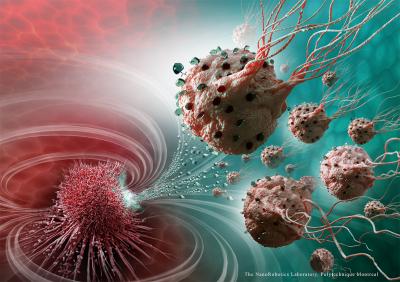
Nanorobots are tackling cancerous tumors
Researchers from Polytechnique Montréal, Université de Montréal and McGill University have just achieved a spectacular breakthrough in cancer research.
The teams have created a team of nanorobots that can navigate through a human’s bloodstream and precisely administer drugs into cancerous tumors. This new way of injecting medication ensures the optimal targeting of a tumor and avoids jeopardizing the surrounding healthy organs and tissues. The new method could also significantly reduce the drug dosage that is highly toxic for the human organism.
The nanorobotic agents were tested on mice and successfully administered into colorectal tumors.

“These legions of nanorobotic agents were actually composed of more than 100 million flagellated bacteria – and therefore self-propelled – and loaded with drugs that moved by taking the most direct path between the drug’s injection point and the area of the body to cure,” said Professor Sylvain Martel, holder of the Canada Research Chair in Medical Nanorobotics and Director of the Polytechnique Montréal Nanorobotics Laboratory, who heads the research team’s work. “The drug’s propelling force was enough to travel efficiently and enter deep inside the tumours.”
Once the robots enter a tumor, they can autonomously detect the oxygen-depleted tumor areas, called hypoxic zones, and deliver the drug to them. This hypoxic zone is created by the substantial consumption of oxygen by rapidly proliferative tumour cells. Hypoxic zones are known to be resistant to most therapies, including radiotherapy.
Since gaining access to these areas via paths as minute as a red blood cell and crossing complex physiological micro-environments does not come without challenges Martel and the team used nanotechnology combat them.
The bacteria relied on two natural systems to move around: a compass created by the synthesis of a chain of magnetic nanoparticles, which allowed them to move in the direction of a magnetic field and a sensor that measures oxygen concentration. These two transportation systems, as well the exposing of the bacteria to a computer-controlled magnetic field allowed the researchers to perfectly replicate artificial nanorobots of the future.
“This innovative use of nanotransporters will have an impact not only on creating more advanced engineering concepts and original intervention methods, but it also throws the door wide open to the synthesis of new vehicles for therapeutic, imaging and diagnostic agents,” said Martel. “Chemotherapy, which is so toxic for the entire human body, could make use of these natural nanorobots to move drugs directly to the targeted area, eliminating the harmful side effects while also boosting its therapeutic effectiveness.”

Comments are closed, but trackbacks and pingbacks are open.